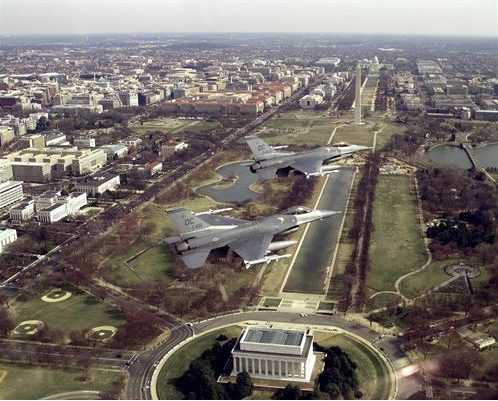 On the morning of September 11, 2001, a duty officer from the 113th Wing, D.C. Air National Guard, called a contact at the Secret Service to see if the attacks in New York had created any airspace restrictions. Moments later, the Secret Service called with instructions from the White House to get the F-16s in the air. The Pentagon had just been hit, and the White House knew another airliner—United Flight 93—had been hijacked.
On the morning of September 11, 2001, a duty officer from the 113th Wing, D.C. Air National Guard, called a contact at the Secret Service to see if the attacks in New York had created any airspace restrictions. Moments later, the Secret Service called with instructions from the White House to get the F-16s in the air. The Pentagon had just been hit, and the White House knew another airliner—United Flight 93—had been hijacked.
After a call with the White House operations center, the 113th Wing commander issued a scramble order to set up a combat air patrol over D.C. and deter all aircraft within 20 miles with “whatever force is necessary… to keep from hitting a building downtown.”
As the first F-16 crew returned due to fuel, the next crew went out. There was no time to arm them with missiles, so each fighter went out with only 500 training bullets—just enough for a five-second burst. At the time, they believed that there may be more hostile aircraft. Each committed to doing whatever necessary to stop any hostile aircraft they encountered—up to and including ramming the airliner. By this point, fighters from Langley and the fighters from the D.C. National Guard were put in contact with each other. Flight 93 was no longer a threat, but the two units worked together to escort aircraft out of the airspace.
Meanwhile, with little more information than several people at the Pentagon were dead and several more injured, D.C. Army National Guard aircrews from the 1-224th Aviation Detachment were called to the Pentagon to assist in the medical-evacuation of causalities to military hospitals. Additionally D.C. Army and Air National Guard Chaplains were call to provide grief counseling to service members and families.
The Mobilization Augmentation Command Detachment 4 was immediately activated, becoming the first National Guard unit mobilized for the Global War on Terror.
In the days after September 11, Soldiers from the D.C. Army National Guard were mobilized around the city, including the Capitol building. Task Force Capital Guardian, consisting of 100 soldiers, was called on by the U.S. Congress to provide perimeter security on the Capitol grounds. Their mission was to help police secure the restricted area around the Capitol and check vehicles approaching the Capitol. It was the first time since the 1968 Washington Riots, following the Dr. Martin Luther King Jr. assassination, that the D.C. National Guard was called to protect the Capitol grounds.
The support was only beginning on 9/11. D.C. National Guard Soldiers and Airmen served stateside providing security at Joint Base Anacostia-Bolling, Joint Base Andrews and the Pentagon in support of numerous Operation Noble Eagle missions. Additionally, many of these same units would go on to deploy overseas in support of Operations Iraqi Freedom, New Dawn, and Enduring Freedom. The D.C. Army and Air National Guard has deployed more than 2,900 personnel in support of the Global War on Terrorism.